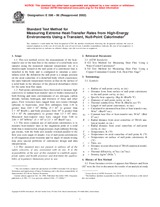Potřebujeme váš souhlas k využití jednotlivých dat, aby se vám mimo jiné mohly ukazovat informace týkající se vašich zájmů. Souhlas udělíte kliknutím na tlačítko „OK“.
ASTM E598-96(2002)
Standard Test Method for Measuring Extreme Heat-Transfer Rates from High-Energy Environments Using a Transient, Null-Point Calorimeter
Automaticky přeložený název:
Standardní zkušební metoda pro měření Extreme Heat - přenosové rychlosti z High - Energy prostředí pomocí přechodný, Null -Point kalorimetr
NORMA vydána dne 10.10.1996
Informace o normě:
Označení normy: ASTM E598-96(2002)
Poznámka: NEPLATNÁ
Datum vydání normy: 10.10.1996
Kód zboží: NS-47342
Počet stran: 10
Přibližná hmotnost: 30 g (0.07 liber)
Země: Americká technická norma
Kategorie: Technické normy ASTM
Anotace textu normy ASTM E598-96(2002) :
Keywords:
calirometer, convective, heat flux, heat flux gage, null-point, radiative, transient temperature, ICS Number Code 17.200.10 (Heat. Calorimetry)
Doplňující informace
| 1. Scope | ||||
|
1.1 This test method covers the measurement of the heat-transfer rate or the heat flux to the surface of a solid body (test sample) using the measured transient temperature rise of a thermocouple located at the null point of a calorimeter that is installed in the body and is configured to simulate a semi-infinite solid. By definition the null point is a unique position on the axial centerline of a disturbed body which experiences the same transient temperature history as that on the surface of a solid body in the absence of the physical disturbance (hole) for the same heat-flux input. 1.2 Null-point calorimeters have been used to measure high convective or radiant heat-transfer rates to bodies immersed in both flowing and static environments of air, nitrogen, carbon dioxide, helium, hydrogen, and mixtures of these and other gases. Flow velocities have ranged from zero (static) through subsonic to hypersonic, total flow enthalpies from 1.16 to greater than 4.65 x 101 MJ/kg (5 x 10 2 to greater than 2 x 104 Btu/lb.), and body pressures from 105 to greater than 1.5 x 10 7 Pa (atmospheric to greater than 1.5 x 10 2 atm). Measured heat-transfer rates have ranged from 5.68 to 2.84 x 10 2 MW/m2 (5 x 102 to 2.5 104 Btu/ft2-sec). 1.3 The most common use of null-point calorimeters is to measure heat-transfer rates at the stagnation point of a solid body that is immersed in a high pressure, high enthalpy flowing gas stream, with the body axis usually oriented parallel to the flow axis (zero angle-of-attack). Use of null-point calorimeters at off-stagnation point locations and for angle-of-attack testing may pose special problems of calorimeter design and data interpretation. 1.4 This standard does not purport to address all of the safety concerns, if any, associated with its use. It is the responsibility of the user of this standard to establish appropriate safety and health practices and determine the applicability of regulatory limitations prior to use. |
||||
| 2. Referenced Documents | ||||
|
Doporučujeme:
Aktualizace technických norem
Chcete mít jistotu, že používáte pouze platné technické normy?
Nabízíme Vám řešení, které Vám zajistí měsíční přehled o aktuálnosti norem, které používáte.
Chcete vědět více informací? Podívejte se na tuto stránku.




 Cookies
Cookies
